Disposable cups and containers, the 2026 update

Disposable Cups and Containers The 2026 Update We talk about it a lot: plastic disposable cups and containers. Every day, 19 million pieces are thrown away in the Netherlands after a single use. One use! And some of it ends up as litter in the environment. It is high time to change this, and fortunately the government agrees. Rules have been in place since 2023, but starting in 2026 things get serious. The idea is simple: reuse must be bigger than disposable. That is why, since July 1, 2023, a mandatory fee applies for take away and delivery for plastic cups and containers. And since January 1, 2024, disposable plastic is no longer allowed for on site consumption. From 2026, a fixed fee of 0.25 euro per order, stricter enforcement, and a clear goal will be added: 40 percent less disposable plastic in 2026 compared to 2022. Disposable should become the exception, reusable the norm, not because it is required, but because it works. These rules are part of the EU Single Use Plastics SUP directive, which simply means: less plastic, less waste, more reuse. From 2026, the system for fees will change: businesses can no longer set the price for a plastic cup or container themselves. One price applies to everyone: 0.25 euro per order. No surprises, no variations per business, just clear and fair. What does this mean in practice? If you order something to go, you will always pay 0.25 euro for a disposable plastic cup or container. Bring your own cup or container, and you often pay nothing extra and sometimes even get a discount. For on site consumption, reusable cups and dishes remain the standard, with exceptions only for closed events and care facilities. For businesses, this means the variable fee disappears and a fixed price applies. The rules for reusable dishes on site remain in place, and enforcement will be stricter, so it is important that your processes are in order. At the same time, it is an opportunity to encourage customers to bring their own container, which is good for the environment and can also be financially advantageous. Why does this work? Reuse is smarter. Less waste means lower costs and less hassle. It benefits not only the environment but also your organization: less disposable purchasing, less waste processing, and satisfied customers who want to make a difference. In short: a win win win. In summary, from 2026 disposable cups and containers for take away will have a 0.25 euro fee, the old variable fee disappears, on site enforcement becomes stricter, and the goal of 40 percent less disposable plastic continues in full force. Reuse becomes the norm, disposable the exception, and honestly, that just feels better.
Budget Day 2025: What do the plans mean for events and venues?

Budget Day 2025: What do the plans mean for events and venues? On Budget Day 2025 the Dutch government presented the Budget Memorandum and the 2026 Tax Plan. As in previous years, the main focus was on the economy, purchasing power and public finances, but there were also important points relating to sustainability, circularity and the financial frameworks that events and venues need to work with. A striking element of the plans is the Climate Fund, which has now become a permanent part of the national budget. This underlines the government’s intention to continue investing structurally in climate measures and the energy transition. For venues and event organisers this could translate into more opportunities to access funding or subsidies for making buildings, installations and infrastructure more sustainable. Examples include improving insulation, using sustainable materials, or installing energy-efficient systems that permanently reduce energy consumption at venues. It also became clear that existing schemes for sustainable investment, such as the EIA, MIA/Vamil and the SDE++, will remain available. Although some budgets have been slightly adjusted, the underlying message is that investing in sustainability will continue to be supported through fiscal incentives. For the events sector this presents opportunities to make technologies such as LED lighting, solar panels, or more efficient heating and cooling systems more financially viable. The emphasis on bio-based construction and sustainable building methods could also inspire venues to look beyond traditional solutions when renovating or constructing new spaces. For organisers there was further good news: the planned VAT increase on culture and sport will not go ahead. The reduced rate of 9 per cent remains in place, preventing ticket prices from rising. This is positive not only for keeping events accessible to the public, but also for the financial stability of organisers, who are already dealing with rising costs elsewhere. Energy costs were also addressed. The government announced compensation for companies facing high electricity bills and a reduction in the CO₂ levy for certain sectors. Since events are often energy-intensive, particularly with regard to lighting, sound and climate control, such measures could provide tangible relief in operational costs. At the same time, the government continues to emphasise budgetary discipline and stability. This gives organisations greater predictability, which is crucial when making long-term decisions on maintenance, investment and contracts. For venues, this means more certainty when planning sustainable upgrades, without the risk of sudden tax changes upsetting financial calculations in the short term. There are, however, some caveats. While there is considerable attention for energy and the built environment, little has been announced that directly addresses circular event management, such as material reuse or innovative waste streams. For now, the sector will need to rely on its own creativity and collaboration with municipalities and partners. Moreover, some of the announced measures will only take effect in 2026, making forward planning all the more important. Taken together, Budget Day 2025 outlines a direction in which the government aims to further support the transition to a more sustainable economy and society, with clear benefits for events and venues. For organisers, it will pay to keep a close eye on which subsidies and schemes are most relevant, and to time renovation or investment plans carefully in order to take full advantage of new measures as they come into effect.
Mobile collection & reusable cups: the future of sustainable festivals
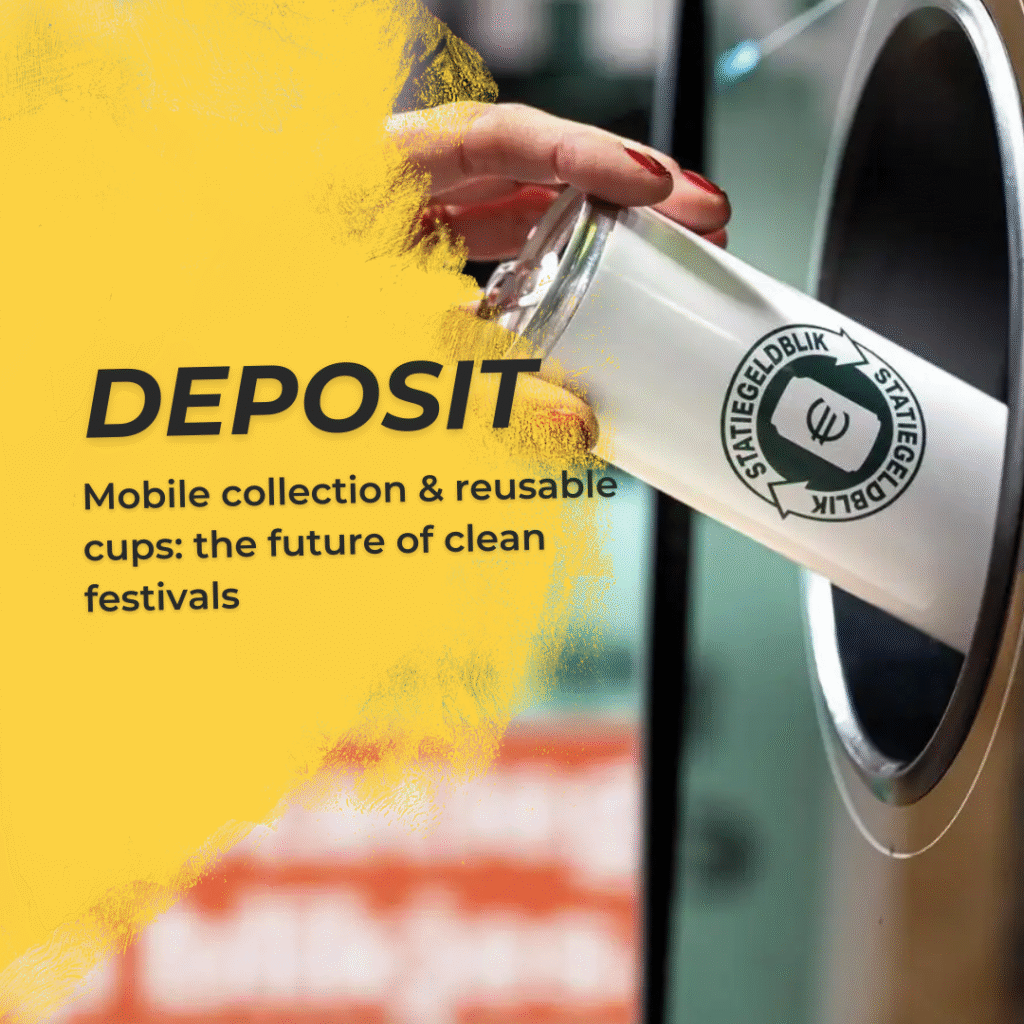
Mobile collection & reusable cups: the future of sustainable festivals We believe that the events industry has the opportunity to become truly circular. That means not only focusing on reusable cups, but also rethinking how we deal with deposit return systems for bottles and cans. At festivals, alongside beer or soft drinks served in reusable cups, a significant number of drinks are still sold in plastic bottles or cans. These carry a deposit, and to make sure they are returned, it must be as quick and easy as possible for visitors to hand them back. What is Statiegeld Nederland?Statiegeld Nederland is the organisation responsible for managing the Dutch deposit return system for plastic bottles and cans. Since 2021 for small plastic bottles, and 2023 for cans, all producers and retailers in the Netherlands have been required to add a deposit to these containers. Statiegeld Nederland oversees the logistics, collection points and financial flows to ensure that as many bottles and cans as possible are returned and recycled into new packaging. Their work is crucial in reducing litter, cutting CO₂ emissions, and creating a closed loop for packaging. Innovation on festivals: mobile bulk machinesDeposit Return Netherlands is now expanding its work to festivals and large public events. During Carnival in six cities, for example, they tested mobile bulk machines that allowed visitors to return over one hundred bottles or cans at once. Festival-goers could choose whether to have their deposit refunded digitally via Tikkie, or to donate it to a local charity. This approach not only makes returning items practical, but also turns it into part of the festival experience. The success of these machines shows that convenience, visibility and direct rewards are key to achieving high return rates and preventing waste. Combining reusable cups with deposit returnFor festivals that already use reusable cups, this development can be the missing link. Reusable cups reduce single-use plastic and cut down drastically on waste, but many drinks are still supplied in bottles or cans. By combining a reusable cup system with mobile deposit return points, organisers can ensure that all packaging, cups, bottles and cans, makes its way back into the cycle. Visitors are more likely to return everything when it is simple, quick and rewarding, while organisers can demonstrate that their event is fully aligned with sustainability goals. The result is a cleaner festival site, a stronger circular economy and a positive experience for everyone involved. Why collaboration mattersA partnership between festival organisers, Rubbish Reusables and Statiegeld Nederland offers a practical solution for sustainable festivals. By setting up mobile return stations or bulk machines across a site, events can integrate deposit return into the visitor journey. This makes handing in bottles and cans just as natural as returning a reusable cup at the bar. At the same time, organisers benefit from reliable logistics, transparent data on collection rates, and the positive branding of hosting a truly circular event. Closing the loop at circular eventsReusable cups provide the foundation for reducing waste at festivals, but the circle is only complete when deposit return systems are seamlessly integrated too. By working together with Statiegeld Nederland, festivals can take a major step towards becoming both waste-free and climate-friendly. This is how sustainable festivals of the future will look: fun, engaging, and a shining example of circular innovation. Read more about the bulk machines during carnival here.
Frequently asked questions about organising a reusable cup system
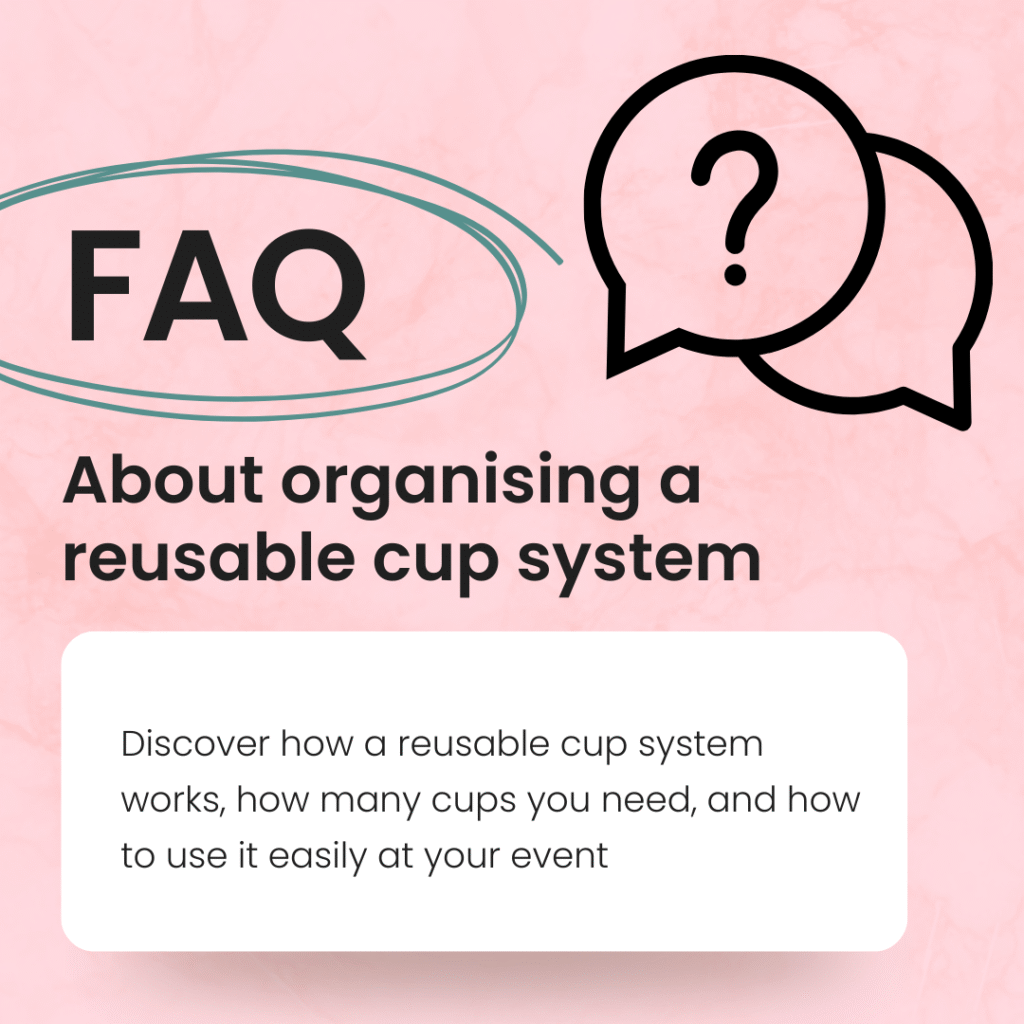
Frequently Asked Questions about using a reusable cup system More and more events are switching to reusable cups. Not only because it is more sustainable, but also because regulations around single use plastics (SUP) are becoming increasingly strict. Still, the transition to a cup reuse system often raises questions for organisers. In this article we answer the most frequently asked questions so you can get started well prepared. How does a reusable cup system actually work? In a reusable cup system, drinks are served in sturdy reusable cups instead of single use versions. Visitors usually pay a small deposit for their cup. At the end of the event they return the cup and receive their deposit back, or they take the cup home as a souvenir. After the event, the returned cups are professionally cleaned and put back into circulation. What are the advantages compared to disposable cups? Reusable cups result in:• A significant reduction in waste streams• Less cleaning up and cleaner event sites• A more sustainable image for the event• When implemented well, an improved visitor experience• Potential long term cost savings through reuse Read more here. How many cups do I need for my event? This depends on the number of visitors, the duration of the event, the type of audience, and whether or not you wash on site. As a guideline, 4 to 6 cups per visitor are often calculated. This way you have enough stock to handle peak moments and to allow for cleaning cycles. Read more here. Who takes care of logistics and cleaning? Rubbish Reusables offers a complete package: delivery of the cups, collection points during the event, transport, and professional cleaning. This takes the pressure off the organiser and ensures everything runs hygienically and efficiently. Read more here. What about the costs and the deposit system? The costs vary per supplier and construction, whether you rent or buy. A deposit system usually works as follows: visitors pay €1 or €2 extra with their first drink. They get this amount back when they return their cup. This encourages cups to be returned and keeps losses to a minimum. Read more here. What if visitors do not return their cup? It is common for a small share of cups to disappear because visitors take them home. This loss is accounted for in advance. Clear communication about the deposit system and having enough return points ensures that as many cups as possible are handed back. Moreover, if a cup is not returned, the organiser is at least not left with the cost. How can I best inform visitors? Clear communication is essential. Provide clear signage and announcements, and involve bar staff in explaining the system. The better visitors understand how it works, the smoother the process will run. Conclusion A reusable cup system may raise questions at first, but in practice both visitors and organisers quickly become familiar with it. The system brings clear benefits for sustainability, event image, and waste management. With the right preparation and communication, you can make your event future proof and much greener.
How many reusable cups do I need?

How many reusable cups do I need? When organising an event, choosing reusable cups is an important step towards sustainability. But how do you determine how many cups you actually need? The right number depends on several factors, such as the size of your event, the number of bars or serving points, the expected visitor numbers, and the duration of the event. A useful rule of thumb is to consider the average use per visitor. At a one day festival a guest typically uses three to five cups, depending on the range of drinks on offer and how busy it is. At multi day events this number tends to be higher, as visitors place orders more frequently across several days. The type of event also matters, since a sports match with short peak moments requires a different approach from a multi day music festival. It is also important to account for the return rate of the cups. At events with a deposit system the majority of cups are returned, but never all of them. A small percentage is either kept by visitors or lost. For this reason it is wise to include a buffer of around ten to fifteen percent extra, so you do not risk running out of cups during your event. The number of serving points also plays a role. If you have many bars spread out across a large site, you will need more cups in circulation to ensure sufficient stock everywhere. Make sure the logistics of collecting, washing, and redistributing cups are well organised, so you can operate efficiently with a limited number of cups. In summary, consider the number of visitors, the duration and type of event, the return rate, and the logistical layout of the venue. By carefully factoring these elements in, you can estimate quite accurately how many reusable cups you will need, ensuring a smooth and sustainable event experience.
Reusable Cups vs. Single-Use: What Does the Visitor Notice?
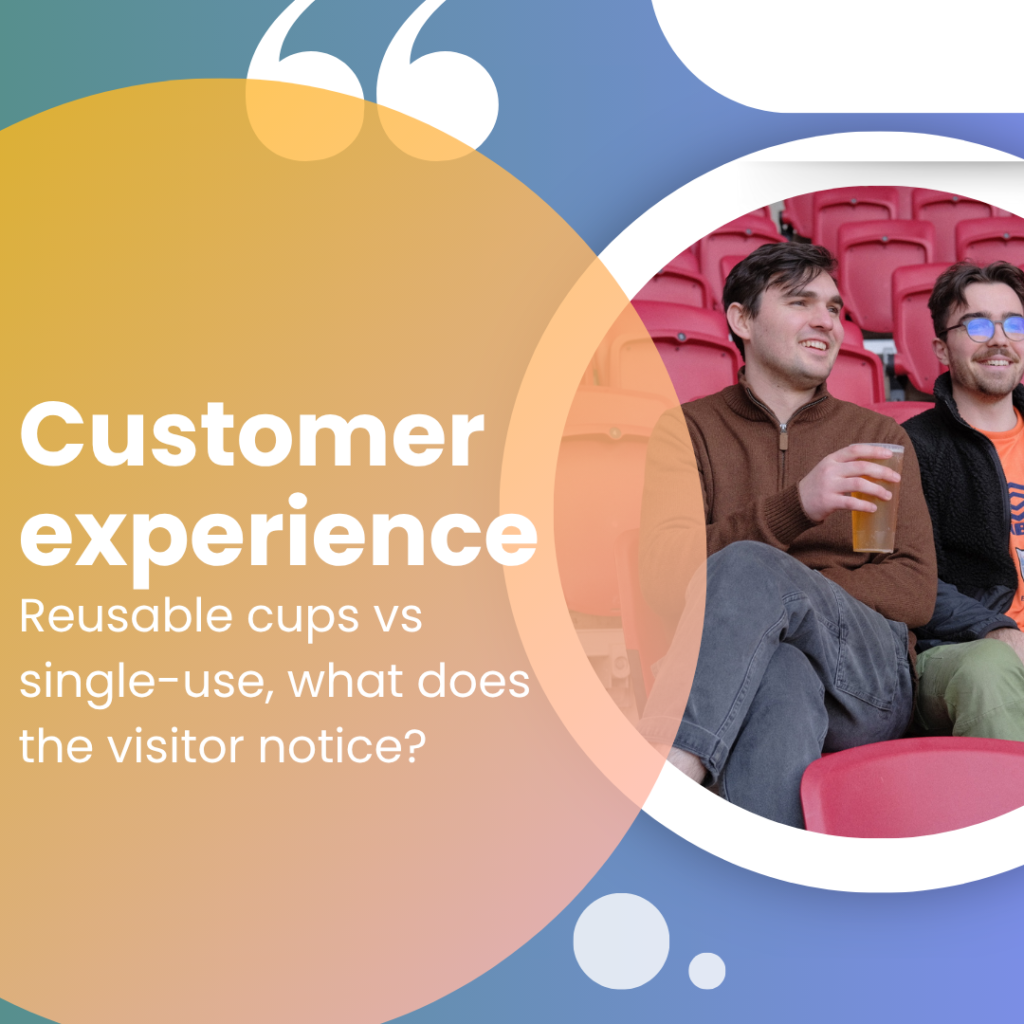
Reusable cups vs. single-use: what does the visitor notice? In the discussion about sustainability at events, the focus is often on environmental impact, regulations, and costs. But what about the visitor’s own experience? How does drinking from a reusable cup compare to a single-use cup? In this blog, we delve into the customer experience, with insights from recent research and practical observations. 1. First impressions matter For many visitors, the experience of a drink begins the moment they hold the cup. A single use cup is light, flexible and feels familiar, it is what many people are used to. They are easy to stack, quick to hand out, and once the drink is finished, there is nothing more to think about. That can be convenient. At the same time, single use cups are sometimes perceived as cheap. In warm weather, they can become soft, and when filled with a heavy drink, they may feel awkward to hold. Especially at festivals where people move around a lot, this can lead to spills or a sense of throwaway culture. Reusable cups, on the other hand, are sturdy, stable and pleasant to hold. They give some visitors the impression that more care has been taken with what they are served. They often feel nicer to drink from, and many people say it gives them a better overall feeling. Others, however, find it inconvenient to carry the cup around or to return it. And if the system is not clearly explained, it can cause confusion. The first moment of physical contact sets the tone, but the experience differs from person to person. 2. Behaviour and convenience A key difference between the two systems lies in what happens after the drink is finished. Even with single use cups, many visitors now hold on to their cup for a refill. The real difference comes at the final drink. In practice, single use cups are often not returned but thrown away. They frequently end up on the ground or beside overflowing bins. With reusable cups, the idea is that they are returned at a designated point or kept for the next drink. This requires a little more attention and cooperation. Many events use a deposit system, where visitors get their money back upon return. This increases motivation, but requires a well-functioning return process. If return points are hard to find, or if people lose their cup, this can lead to frustration. Nonetheless, research by Green Events shows that visitors are often willing to take part in a reusable system, especially if it is clearly explained and well organised. 3. Hygiene and perception One common concern with reusable cups is hygiene. Visitors want to be certain that a cup has been properly cleaned. Events using professional washing facilities or mobile rinsing units can provide that assurance. Transparency about the cleaning process, such as through visuals or QR codes, helps build trust. Single use cups are often seen as more hygienic, but this is mostly a matter of perception. In reality, reusable cups that are properly cleaned are just as hygienic, according to a study by Wageningen University, 2019. 4. Experience influences behaviour Interestingly, the type of cup influences behaviour. Organisers often notice that reusable cups are less likely to be dropped on the ground. They feel more valuable, so visitors tend to treat them with more care. This results in cleaner grounds and a more pleasant atmosphere. At the same time, some events have found that switching to reusable cups led to more litter, especially if the system was new to the audience or if there was little guidance. So it is not just the cup itself, but the way the system is set up, that determines success. 5. Preference for reusable comes from different directions Research by Emerald Publishing, 2024, shows that visitors see reusable cups not only as more environmentally friendly, but also as higher in quality and more socially accepted. The appearance of the cup and the feeling that others are doing the same play an important role in shaping preference. When the system is clearly explained and well supported, people are more likely to choose reusable, even if it offers slightly less convenience. Conclusion, experience makes the difference The choice between reusable and single use cups goes beyond sustainability or regulations. For visitors, it is about convenience, comfort, clarity and trust. A single use cup is light and familiar, and requires little effort. A reusable cup feels more solid, gives a more thoughtful impression, but also asks a bit more from both the visitor and the organiser. What stands out is that the experience of the system is closely linked to how it is implemented. With clear communication, enough return points and good overall organisation, many visitors are not only willing to take part, but even prefer reusable solutions. The cup plays a role, but the bigger picture ultimately shapes the experience. There is no clear winner, but there is plenty to gain from a smart and well supported approach. That is where the key lies to a successful and positive visitor experience.
Renting or owning cups: what suits your event best

Renting or owning cups: what suits your event best Reusable cups have become the norm at more and more events. Not just because of legislation, but also because visitors appreciate it when an event is set up sustainably. Still, switching to reusables often raises one key question: should you rent the cups, or is it better to buy your own? There is no one-size-fits-all answer. The right choice depends on the type of event, how often it takes place, the available storage capacity and your budget. In this blog, we help you make a well-informed decision. What are your starting points? One-off event with a limited budget Are you organizing a one-time event, such as a village fair, a pop-up food festival or a municipal celebration? In that case, renting is often the most logical option. You don’t need to store or clean the cups yourself, and you only pay for what you need for that edition. It’s a low-threshold way to work with reusable cups without requiring a major upfront investment. Benefits of renting: • No investment in your own stock• No concerns about cleaning or storage• Ideal for irregular or one-time events Recurring event or permanent location Do you organize multiple events per year, or work at a location with frequent visitors, such as a city park, sports club, cultural venue or festival site? Then owning your own cup supply may be more attractive. By using cups multiple times, your cost per use goes down. You can also customize your cups with your own logo or branding, which helps increase visibility and reinforce your identity. Benefits of owning cups: • Lower costs in the long term• Custom branding possible• Always available during peak moments or last-minute events A combination is also possible More and more organizers choose a hybrid model. They invest in a basic stock of commonly used cup sizes for standard moments, and rent additional cups or specific formats like pitchers or wine cups during peak moments or for larger events. This keeps your investment manageable and gives you maximum flexibility. And what about the ecological impact? Whether you rent or buy, Rubbish Reusables always provides an impact report. This shows how much CO2 and waste has been saved by using reusable cups. It’s not only useful for your own evaluation, but also for reporting to municipalities, licensing authorities or partners who value sustainability. Need help deciding? Still unsure whether renting or owning is the best fit? Or would you like to explore how a combination might work for your event? We are happy to help you assess your options based on your event calendar, audience size and location. Contact us at or schedule a non-binding consultation.
How are reusable cups washed? Everything you need to know
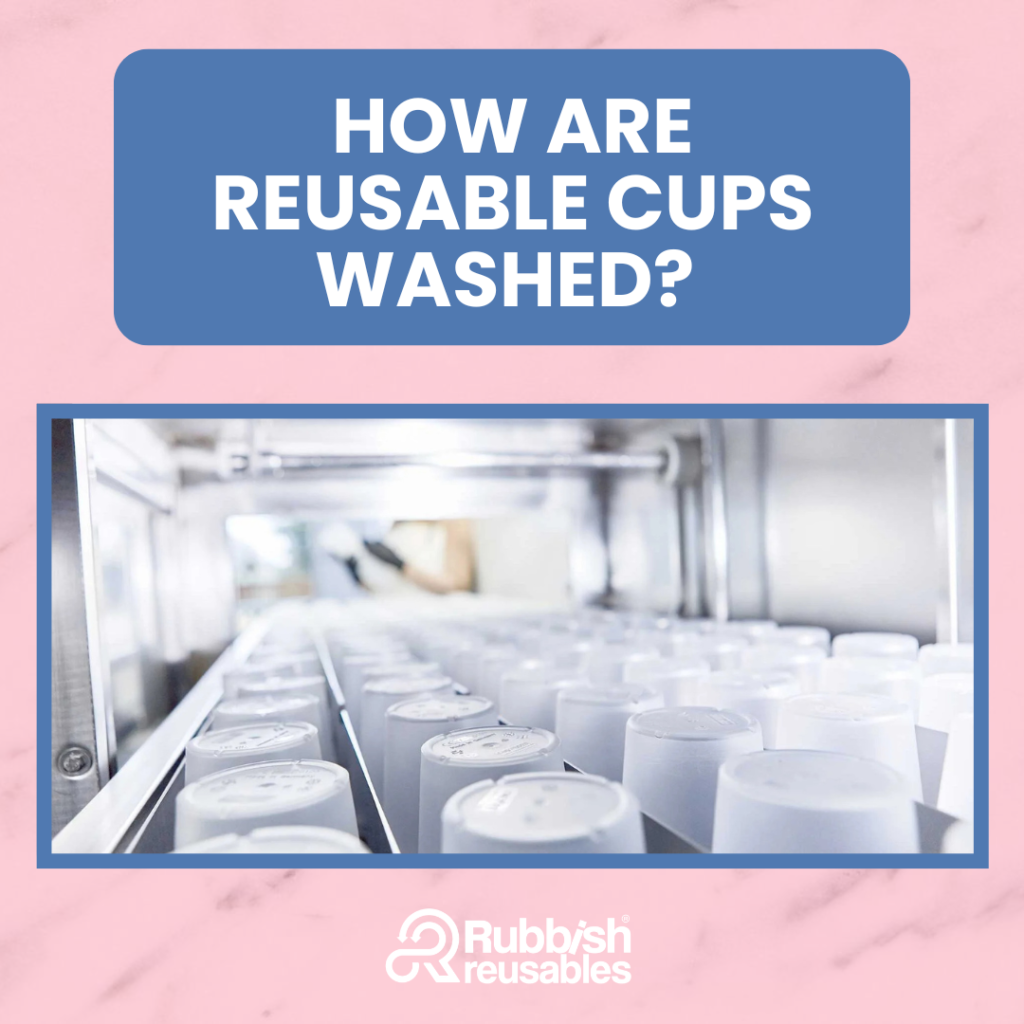
How are reusable cups washed? Everything you need to know Washing is the driving force behind reuse. Every time a reusable cup is professionally cleaned, we save resources, reduce waste, and extend the product’s lifespan. The washing process isn’t just necessary, it makes reuse possible. At Rubbish Reusables, we take this process extremely seriously, with care, precision, and a healthy dose of passion for sustainability. In this blog, we explain how our washing system works, how we organise transport and logistics, and how we ensure a constant flow of clean cups, even during large-scale events. When and how are reusable cups washed? After use, all cups are professionally cleaned in our specialised washing facilities. This guarantees absolute hygiene, but also ensures that the cups last longer and can be used again and again. As a customer, you don’t have to worry about a thing, we take care of the entire process.Here’s how it works: Cups are collected after use in sealable crates or containers. They are picked up and transported to a professional washing facility. In industrial dishwashers, the cups are thoroughly washed, disinfected and dried. We then store them hygienically or deliver them again for their next use. Thanks to this streamlined approach, our cups are always clean, safe, and ready for the next round. On-site rinsing at city-wide events At events where cups need to be reused quickly, such as city festivals, concerts, or sporting events, we also offer flexible solutions for on-site rinsing. Two commonly used options: Rinsing by hospitality partners: For short-term reuse on the same day, hospitality operators can rinse the cups themselves, for example using a rinsing sink or dishwasher behind the bar. Mobile rinse units: For larger events, we can deploy mobile rinse stations. This allows cups to be cleaned and ready for use again within minutes, without needing to return to the central washing facility. This makes it possible to safely and efficiently reuse large volumes of cups, even during peak times. Professional cleaning is always part of the system At Rubbish Reusables, washing isn’t an optional service, it’s an essential part of our product. We believe professional cleaning is the key to a reliable and sustainable reusable cup system. It ensures consistency, prevents loss of quality, and meets the strictest hygiene standards. There’s no need, or reason, to wash the cups yourself. By leaving the process to us, organisers and businesses can count on convenience, quality, and smooth operations. Conclusion Reusable cups are not only an environmentally friendly alternative to single-use items, they are a smart, future-proof choice. But reuse only works when every part of the system is right. At Rubbish Reusables, we provide that foundation: professional cleaning, reliable logistics, and smooth redeployment. Together, we’re building a circular system, hassle-free, waste-free, and always with a clean start
Festival cups and deposits: how does it actually work?
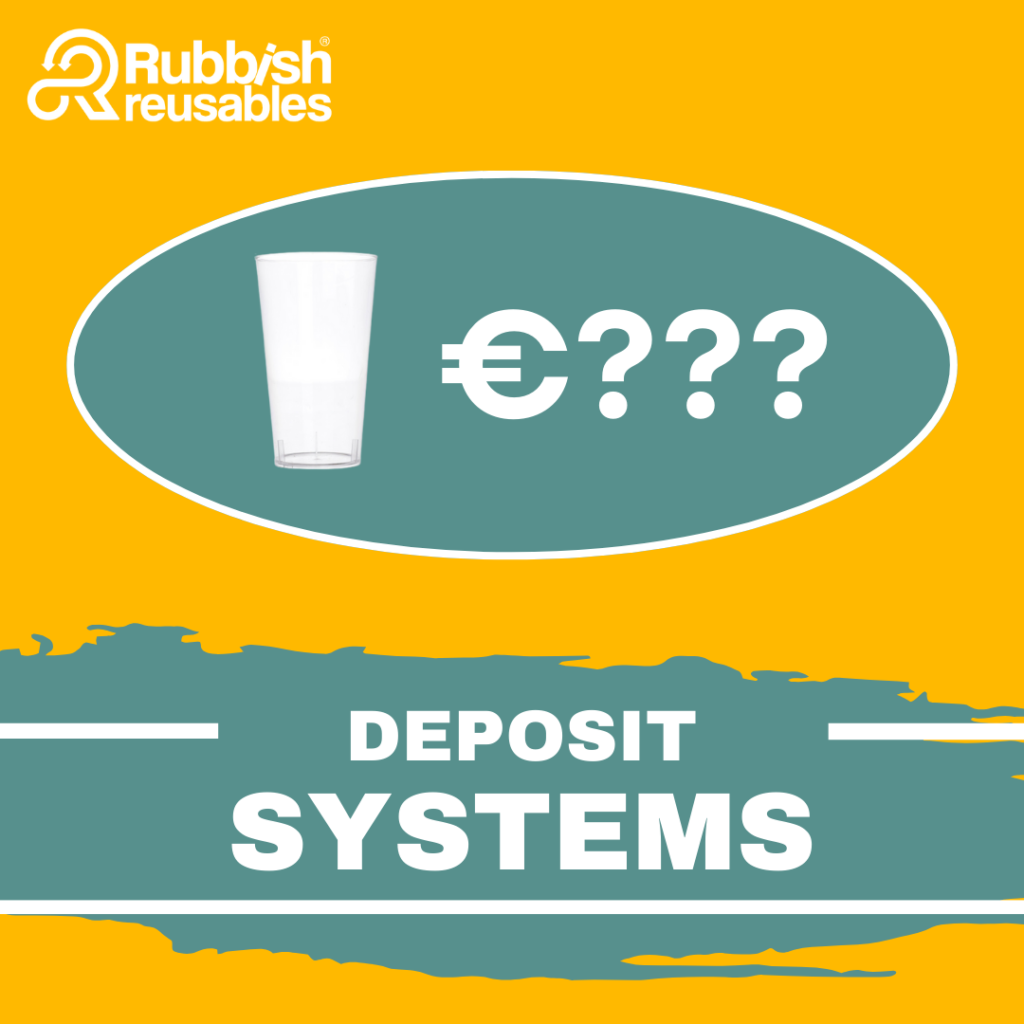
Festival cups and deposits: How does it actually work? At festivals these days, it’s become the norm: your drink comes in a sturdy, reusable cup. This almost always involves some form of deposit. But exactly how that works varies from one event to another. Sometimes you hand in a token, other times you pay an extra euro and only get part of it back. This often leads to confusion among visitors. Why are there so many different systems? And which approach works best? The Token System A commonly used method is that you receive a token upon entry. You hand this in when getting your first drink, allowing you to receive a cup at no extra charge. For each new drink, you exchange your empty cup for a clean one. If you lose your cup, you pay a deposit for a new one. This system lowers the threshold for that first drink and is relatively simple. However, the downside is that unused tokens can lead to unnecessary plastic use. On top of that, the tokens are small and easily lost in nature or end up in general waste at home. Deposit with (Partial) or Full Refund With this system, you pay an additional fee usually around one euro when ordering your drink, as a deposit for the cup. If you return the cup at a designated return point, you get that amount (or part of it) back. In some cases, it’s fifty cents, but more and more festivals are opting to refund the full deposit. A full refund is very transparent and strongly encourages people to return their cups. However, this system requires good organisation, plenty of return points, and clear instructions about where, when and how to get your money back. Cup Fee Without Refund Some events charge a fixed, one off fee for your cup, say, one euro without any refund. This means there’s no deposit or return incentive. The main advantage is simplicity: no extra steps or return stations are required. The downside is that the incentive to return the cup is much lower, which can reduce both reuse and collection. Clear explanation and motivation remain essential here. Digital Deposits The modern version of the physical token: digital deposits. This can be integrated into a festival wristband or app. The deposit is automatically added to your digital profile at checkout. When you later return the cup, your balance is adjusted. This approach fits well with fully cashless festivals. It offers convenience, although it can sometimes be less visible for visitors how the deposit is processed or refunded. Donating Your Deposit A unique variation allows visitors to donate their deposit. You return your cup to a special bin, and the associated value is donated to a charity. This links sustainability with social impact. The approach is often well received especially when it’s clear where the donation is going. That’s why clear communication about the cause and the total amount raised is crucial. What Works Best? There’s no single ‘best’ system. What works well for a small, local festival might not be suitable for a large dance event with thousands of attendees. What’s always important, though, is simplicity and clarity. The better visitors understand how the system works, the more likely they are to return their cups and support the system as intended. At Rubbish Reusables, we believe that smart, practical solutions contribute to a more sustainable festival experience. Whether it’s tokens, digital deposits or an exchange system if it encourages reuse and is clearly explained, the impact is immediately visible. Every returned cup counts.
The Difference Between Hardcups and Softcups
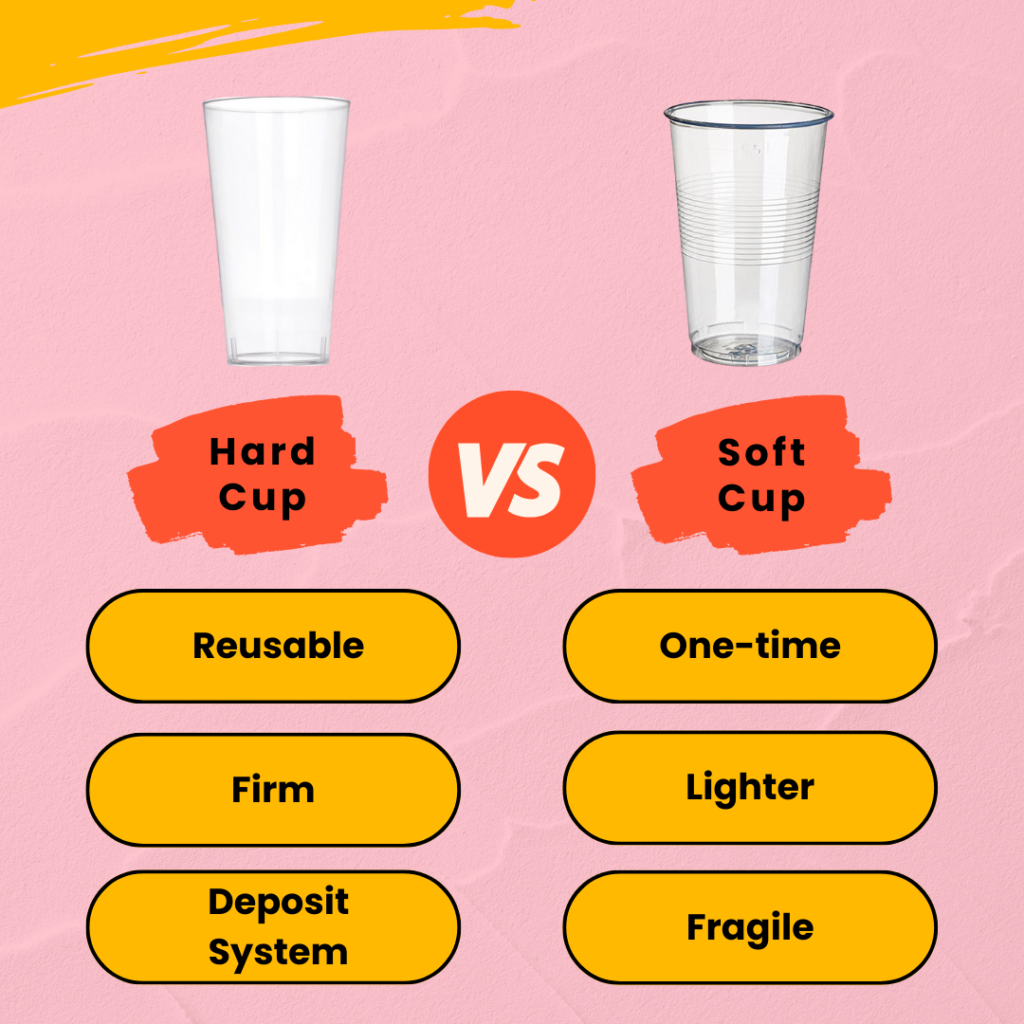
The Difference Between Hardcups and Softcups At Rubbish Reusables, we stand for sustainability and reusable solutions that help businesses operate more efficiently. One of the most frequently asked questions we receive is about the difference between hardcups and softcups. Both options have their own advantages and areas of application. In this blog, we explain what these differences are and how they are used. What Are Hardcups? Hardcups are reusable cups made from durable materials such as polycarbonate, polypropylene or stainless steel. They are designed for long-term use and can be washed many times without significant wear. Thanks to their sturdiness, they are less likely to break and help keep drinks hot or cold for longer. Events and hospitality venues often use hardcups within deposit systems to reduce waste. Visitors pay a deposit and can return the cup later.Although hardcups are generally more sustainable, they also come with drawbacks. They require more storage space, have a higher initial cost, and must be managed effectively from a logistical standpoint to remain efficient. What Are Softcups? Softcups are disposable cups typically made from lightweight plastics such as polyethylene terephthalate (PET) or polypropylene (PP). They are light, flexible, and easy to stack, which makes storage and transport more efficient. Softcups are mainly used as single-use cups at events, festivals, and hospitality venues where speed and convenience are key. Although softcups are cheaper to purchase than hardcups, they also have disadvantages. They wear out quickly, cannot or can hardly be reused, and generate a lot of waste. As a result, they are becoming less attractive in a time when sustainability and eco-friendly alternatives are becoming the norm. The European SUP legislation has a major impact here, as softcups are considered single-use plastics and fall under stricter regulations. The Impact of the SUP Legislation The European Single-Use Plastics (SUP) legislation, introduced in 2021, has a significant influence on the choice between hardcups and softcups. The aim of the law is to reduce plastic waste by restricting single-use plastics, such as softcups. Businesses are encouraged to switch to reusable alternatives like hardcups, which meet the SUP guidelines for long-term use. Softcups fall under stricter rules and may even be banned or subject to additional charges in some regions. The legislation also promotes the use of deposit systems, which are well-suited to hardcups. This not only helps companies comply with the law but also supports a circular economy, in which cups are reused multiple times rather than thrown away. How Many Uses Does a Reusable Cup Need to Be More Environmentally Friendly Than a Disposable One? The exact tipping point at which a hardcup becomes more environmentally friendly than a softcup depends on several factors. Consider how often the cup is used before being washed, how and where it is cleaned, and whether it is recycled or incinerated at the end of its life. It also matters whether cups are rinsed in between uses or professionally cleaned after every use. The actual environmental benefit therefore strongly depends on usage and logistical processes. To give an indication of the emissions, you’ll find below a table with CO₂ emission figures sourced from DEFRA (Department for Environment, Food & Rural Affairs). At Rubbish Reusables, we offer high-quality and sustainable solutions tailored to diverse business needs. Would you like to learn more about our reusable cups and how they can help your business become more sustainable? Please get in touch with us and explore the possibilities! Om toch een indicatie te geven van de uitstoot, vind je hieronder een tabel met CO₂-uitstootcijfers afkomstig van DEFRA (Department for Environment, Food & Rural Affairs). Bij Rubbish Reusables bieden we hoogwaardige en duurzame oplossingen die passen bij diverse bedrijfsbehoeften. Wil je meer weten over onze herbruikbare bekers en hoe ze jouw bedrijf kunnen helpen verduurzamen? Neem dan contact met ons op en ontdek de mogelijkheden!
